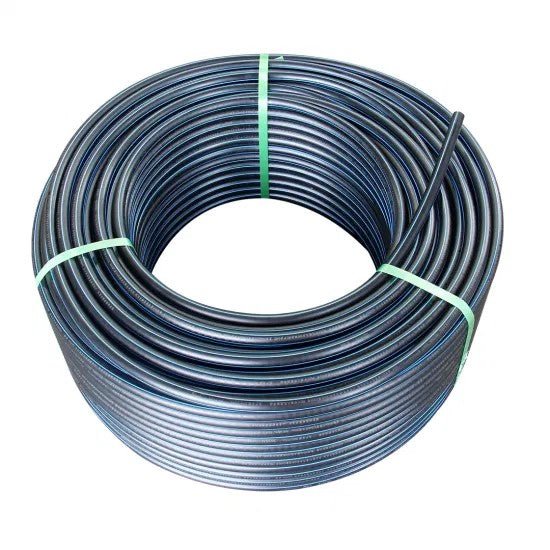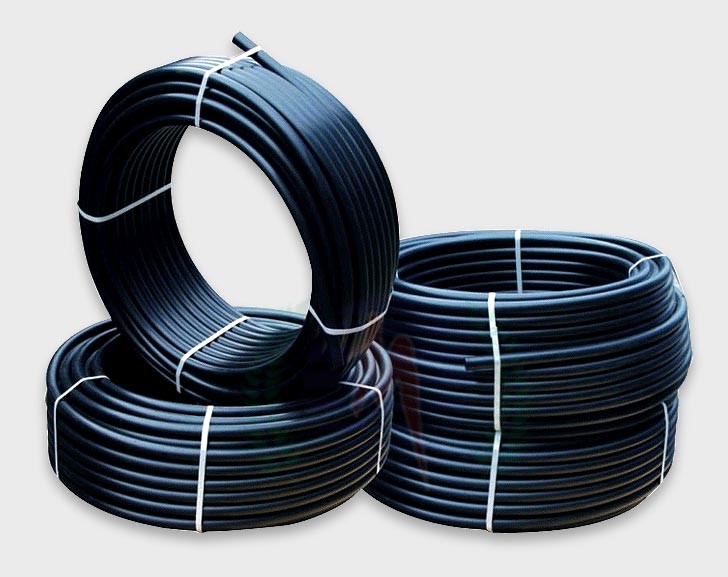Discover the Production Refine Behind High-Quality HDPE Pipeline and Its Applications
The production procedure of top quality HDPE pipelines is intricate and methodical. It begins with the option of basic materials that improve performance. Following this, ethylene goes through polymerization to develop material, which is after that formed via extrusion. Quality assurance is paramount, guaranteeing that the final product meets stringent criteria. Nevertheless, the trip of HDPE pipelines doesn't end with manufacturing. Their applications throughout numerous sectors disclose a wider significance worth taking a look at.
Understanding HDPE: Residences and Advantages

High-density polyethylene (HDPE) is a versatile polycarbonate understood for its durability and resistance to various ecological elements. This product displays superb tensile toughness, making it appropriate for demanding applications. Its low-density framework adds to a lightweight item, promoting convenience of dealing with and installment. HDPE also showcases exceptional resistance to chemicals, which reduces degradation when subjected to harsh materials.
The product's low moisture absorption better enhances its long life, making it excellent for usage in pipelines and tank. Additionally, HDPE is immune to ultraviolet (UV) radiation, ensuring that products keep their honesty even when subjected to sunlight. Its flexibility allows for the development of elaborate forms without endangering stamina. The green nature of HDPE, commonly stemmed from recycled materials, adds to its charm, advertising lasting techniques in production. Overall, these properties and advantages make HDPE a recommended selection for numerous commercial and consumer applications.
Basic Material Choice for HDPE Production
The choice of raw materials for HDPE production is essential to confirm the end product meets the wanted specifications and top quality requirements. High-density polyethylene (HDPE) is mostly created from polymerized ethylene, derived from nonrenewable fuel sources such as gas or petroleum. The high quality of these feedstocks substantially influences the mechanical and thermal buildings of the final HDPE.
Ingredients additionally play a significant function in improving HDPE's performance, including anti-oxidants, UV stabilizers, and colorants, which boost resilience and resistance to environmental factors. The selection procedure need to consider not only the chemical composition of the raw products however also their processing attributes to ensure efficient production.
In addition, the sourcing of resources should focus on sustainability and conformity with environmental laws, as accountable practices are crucial in today's market. Eventually, careful resources selection lays the structure for producing high-grade HDPE pipes suitable for varied applications.
The Extrusion Process: Shaping HDPE Pipeline
The extrusion process plays an essential duty in forming HDPE pipes, starting with precise product preparation techniques that guarantee perfect circulation and consistency. Similarly crucial is the design of the die, which straight affects the last dimensions and surface quality of the pipeline. Together, these aspects add greatly to the performance and quality of HDPE pipe production.
Product Preparation Methods
Effective manufacturing of HDPE pipelines begins with careful product preparation methods, specifically the extrusion process. During this phase, high-density polyethylene material is initial dried to remove wetness, making certain optimal circulation qualities. The material is then fed right into the extruder, where it undertakes heating and melting, transforming into a viscous state. This home heating procedure is meticulously controlled to maintain the product's honesty and efficiency. The liquified HDPE is forced through a die, shaping it right into a continuous pipe form. Proper temperature administration during extrusion is crucial, as it straight affects the material's properties and the final item quality. Once shaped, the HDPE pipe is cooled and reduced to defined lengths, prepared for subsequent processing and applications.
Die Layout Importance
Precision in die design plays a vital duty in the extrusion procedure of HDPE pipelines. The die functions as the final shaping tool, straight influencing the pipeline's dimensions, wall density, and surface area coating. A well-designed die assurances uniform material circulation, lowering problems such as irregularities and weak spots. The geometry of the die must be optimized to suit the details properties of HDPE, including its thickness and thermal actions during extrusion. Additionally, the cooling rate of the material as it passes with the die can substantially affect the pipe's architectural honesty. Consequently, purchasing innovative die modern technology is important for manufacturers intending to produce premium HDPE pipes that fulfill sector requirements and consumer assumptions.
Quality Control Procedures in HDPE Manufacturing
Different factors influence the quality of HDPE pipeline manufacturing, efficient quality control steps are critical to ensure uniformity and integrity in the final product (Pipe Manufacturing Midland TX). Trick quality assurance practices include extensive product inspection, verifying that the raw polyethylene fulfills established standards for purity and density. During the extrusion process, specifications such as temperature level, stress, and cooling time are very closely kept track of to preserve dimensional precision and architectural stability
Additionally, post-production screening is necessary; producers typically carry out hydrostatic examinations to examine the pipeline's stamina and resistance to stress. Aesthetic examinations for surface area issues better enhance quality assurance. Certification from relevant standards organizations, like ASTM or ISO, supplies an extra layer of reliability. By carrying out these Pipe Supplier American Plastics Midland extensive quality assurance steps, makers can minimize defects, improve performance, and make certain that the HDPE pipelines meet the particular demands of numerous applications, inevitably bring about customer satisfaction and trust in the item.
Applications of HDPE Pipe Across Industries
HDPE pipes are utilized across various fields because of their longevity and convenience. In water circulation systems, they ensure efficient distribution, while in wastewater management, they supply dependable solutions for waste transportation. Furthermore, agricultural irrigation networks gain from HDPE's resistance to deterioration and adaptability, making it a suitable option for modern farming practices.

Water Circulation Systems
A considerable number of sectors count on high-density polyethylene (HDPE) pipes for effective water distribution systems. Recognized for their longevity and resistance to deterioration, HDPE pipes are commonly used in metropolitan water supply networks, farming irrigation, and commercial applications. Their lightweight nature facilitates easy handling and installment, reducing labor expenses and time. Furthermore, HDPE pipelines can accommodate numerous stress levels, making them suitable for both low and high-pressure systems. hdpe pipe fittings Midland TX. The versatility of the material enables for smooth combination right into existing infrastructure, reducing the need for extensive excavation. HDPE's resistance to chemical leaching assurances that the water delivered continues to be secure and clean, making it a suitable selection for keeping the top quality of drinkable water across different fields.
Wastewater Monitoring Solutions
Effective water circulation systems also lead the way for ingenious wastewater administration options, where high-density polyethylene (HDPE) pipelines play a significant role. Distinguished for their longevity and resistance to deterioration, HDPE pipelines are excellent for moving wastewater in various settings. Their flexibility enables easy installation in intricate environments, minimizing the need for extensive excavation. Additionally, HDPE's smooth indoor surface decreases friction, enhancing flow prices and performance. These pipes are likewise resistant to chemical leaching, guaranteeing that contaminants do not compromise the surrounding setting. Industries, communities, and treatment facilities increasingly depend on HDPE pipelines for their dependability and longevity, making them a favored selection for modern-day wastewater administration systems. This adaptability emphasizes the essential significance of HDPE pipes across countless applications.
Agricultural Irrigation Networks
Agricultural irrigation networks profit significantly from making use of high-density polyethylene (HDPE) pipes, which give effective and dependable water distribution to crops. HDPE pipes are light-weight, making them simple to transport and mount, while their versatility enables various configurations in varied surfaces. These pipes show exceptional resistance to deterioration, chemicals, and UV radiation, ensuring toughness in extreme farming settings. In addition, their smooth interior surface area reduces rubbing loss, optimizing water flow and lowering energy prices connected with pumping. The longevity of HDPE pipelines, typically going beyond 50 years, contributes to decrease maintenance and replacement expenditures. Farmers progressively count on HDPE pipelines to enhance irrigation performance and promote sustainable agricultural methods, ultimately leading to improved plant yields and resource conservation.

Future Trends in HDPE Pipeline Innovation
As the need for sustainable and efficient framework grows, advancements in HDPE pipeline technology are positioned to transform numerous sectors. Emerging fads consist of the integration of wise technologies, such as sensors and IoT abilities, which promote real-time monitoring of pipe conditions, lowering upkeep expenses and avoiding leakages. In addition, the growth of sophisticated manufacturing strategies, such as 3D printing, is making it possible for the manufacturing of complex, tailored pipe styles that deal with certain job requirements.
The emphasis on recycling and round economic climate techniques is driving the innovation of HDPE pipes made from recycled materials, improving sustainability. Boosted jointing approaches, such as electro-fusion and mechanical installations, are likewise enhancing installment effectiveness and dependability. The growing emphasis on ecological policies is pressing makers to embrace greener manufacturing procedures, ensuring that HDPE pipelines not only satisfy market standards yet additionally foster a more lasting future for framework advancement.
Often Asked Questions
How Does HDPE Contrast to Various Other Plastic Products?
HDPE outmatches many various other plastic materials concerning longevity, chemical resistance, and adaptability. Its low density and high tensile stamina make it ideal for numerous applications, typically exceeding alternatives in both performance and durability.
What Are the Ecological Impacts of HDPE Production?
The ecological impacts of HDPE production consist of greenhouse gas discharges, power usage, and prospective pollution from making procedures. Additionally, improper disposal can result in dirt and water contamination, increasing problems about lasting ecological results.
Can HDPE Pipeline Be Reused?
Yes, HDPE pipes can be recycled. Several centers accept made use of HDPE for processing, transforming it right into brand-new items. This reusing adds to sustainability initiatives, minimizing plastic waste while saving sources and energy in the manufacturing cycle.
What Is the Lifespan of HDPE Piping?

How Do Temperature Variants Affect HDPE Pipeline Performance?
Temperature level variants considerably affect HDPE pipeline efficiency, affecting flexibility and strength. Heats can result in softening, while reduced temperatures may trigger brittleness, eventually affecting the pipeline's sturdiness and viability for different applications in varied atmospheres.